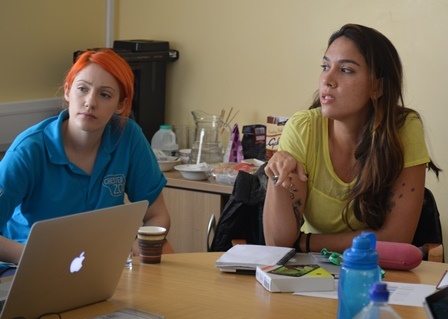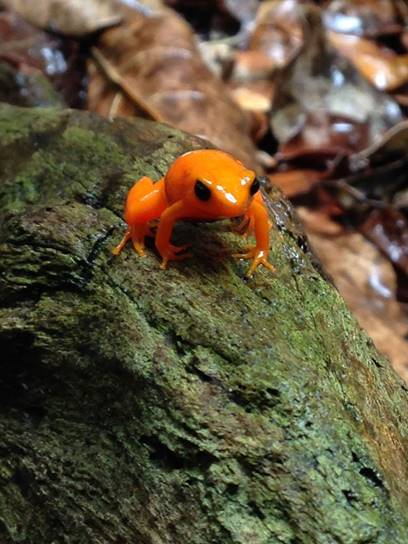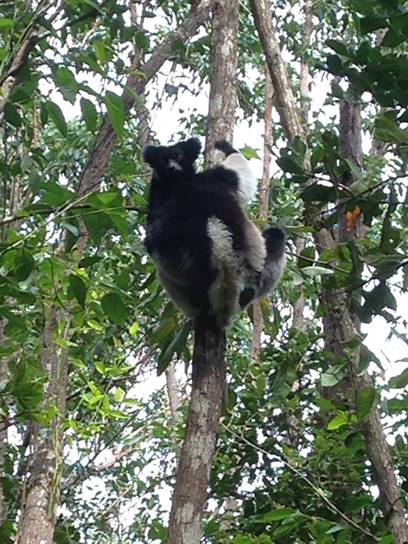Chester Zoo’s golden mantella frogs are playing an increasingly important role in conservation as their species is critically endangered in the wild. The reintroduction of endangered species into their natural habitat has sometimes proved difficult – it’s not just as simple as putting them back in the wild.
By evaluating the ‘fitness’ of the zoo population of golden mantella we can then improve the success of reintroduction attempts. Chester Zoo Conservation Scholar Luiza Passos is a PhD student at the University of Salford. She has been working closely with our curator of lower invertebrates and invertebrates, Gerardo Garcia, and team manager of lower vertebrates and invertebrates, Ben Baker, to evaluate the population of golden mantella at the zoo.

Luiza Passos (right) at Chester Zoo discussing her research with staff
Their research involves measuring the characteristics of golden mantellas, such as color patterns, vocalisation, body condition and behaviour at the zoo, and comparing this to the information gathered in the field in Madagascar. The aim is to increase our understanding of where conditions can be enhanced to ensure optimal fitness for future in-situ generations of golden mantella.
Below Luiza tells us more about her research:
“In zoo conservation breeding and reintroduction is becoming a high profile conservation tool for many species threatened with extinction. However, before reintroducing any species back into the wild, research is needed to help make more informed decisions and improve the success rate.
“The reintroduction of endangered species into their natural habitat has proved difficult. If animals are to be released into the wild these questions need to be addressed. With this in mind I decided to target my PhD research on measuring the characteristics of golden mantellas at the zoo and comparing these to the information gathered in the field in Madagascar.”
The aim of Luiza’s research is to increase our understanding of where conditions can be enhanced even further to ensure optimal fitness for future in-situ generations of golden mantella and increase the success of reintroduction programmes.
 Golden mantella frog. Photo credit: Luiza Passos
Golden mantella frog. Photo credit: Luiza Passos
“The species I focused my research on is the golden mantella frog (Mantella auriantaca) from Madagascar. These amazing little creatures are endemic to Madagascar and are currently considered by the IUCN Red List as ‘critically endangered’ due to habitat destruction (mainly mining) and over exploitation for the pet trade market. Reintroduction is one of the many conservation tools described on the species’ conservation action plan to help save it from extinction in the wild.
“I will be analysing a variety of characteristics that are crucial for the survival of golden mantellas in the wild such as:
Skin coloration – this is important for finding a mate and keeping predators away.
Skin microbiota – this is a measurement of their immune system capabilities.
Vocalisations – this is important for attracting a mate.
Body condition – this shows how healthy individuals are.
“Data from a healthy wild population is being used as a baseline for comparison with a variety of populations in the UK and Madagascar. I have already had the opportunity to go to Madagascar twice in for fieldwork to collect data from a wild population. Field work in Madagascar is a truly amazing experience; waking up each day to the sound of indri lemurs and seeing all these tiny orange frogs hoping around the forest floor is just beyond words! The fieldwork is done in partnership with Chester Zoo’s project partners Madagasikara Voakajy.
 Indri lemur. Photo credit: Luiza Passos
Indri lemur. Photo credit: Luiza Passos
“On my second trip to Madagascar I also had the opportunity to visit Andasibe and collect data from a conservation breeding centre at the Mitsinjo Association. Housed at Mitsinjo is a founder population of golden mantellas and their first offspring as a genetic resource, or safety net population, for future reintroduction programmes.
“In addition to fieldwork in Madagascar I have also been collecting data from the population at Chester Zoo to be compared with wild and Mitsinjo’s animals. At the moment I am analysing all the data I have collected from all these different populations to be able to understand when reintroduction would be a viable option for this species. I already have some preliminary data, which shows some reassuring results, such as the fact that the Chester Zoo population is very healthy. There is still a lot of work to be done in my PhD before I have some definitive conclusions. I’ll keep you updated with progress of my research.”
If you want to hear more from Luiza and learn more about her PhD work – which is funded through a scheme based in Brazil called ‘Science without Borders’ – watch this video created by the University of Salford.